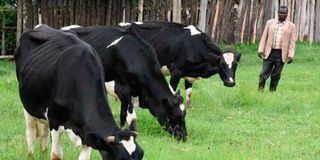Fact check: No, Bill Gates did not say that a cow emits more pollution than cars

A farmer grazing cows. To reduce methane being produced by livestock, methane reducing feed additives and supplements are encouraged.
In an October 2021 white paper, Billionaire philanthropist Bill Gates, while speaking about how to build a zero emissions economy, noted that it would be an important step in avoiding the worst effects of climate change.
In the paper, he spoke about the contributions of various sectors and players to greenhouse emissions. However, an Instagram user misquoted Gates, and in an Instagram post, claimed that Gates and Congresswoman Alexandria Ocasio-Cortez (AOC) said a cow emits more pollution than a car.
The post, uploaded by Range magazine on March 2, and which had 385 likes, read: “Bill Gates and AOC are now claiming that a cow emits more pollution than a car. Let me propose this: I’ll lock myself in a garage with a cow. They can lock themselves in a garage overnight with a running car. In the morning we can meet up to discuss the results.”
This claim, however, is false on two fronts.
First, there is no evidence that Bill Gates nor Alexandria Ocasio-Cortez said so, and science shows that a car emits more emissions as compared to a cow.
In his presentation, Bill Gates classified global sources of greenhouse gases, specifically noting that passenger cars contributed seven per cent of emissions, compared to six per cent produced by livestock.
Besides, 2020 data by the United States Environmental Protection Agency (EPA) shows that the transportation industry generates the most emissions (27 per cent) as compared to other sources, including electricity production (25 per cent), burning fossil fuels (24 per cent), commercial and residential (13 per cent), agriculture (11 per cent) and land and forestry (13 per cent.)
EPA also notes that a typical passenger vehicle emits around 4.6 metric tons of carbon dioxide per year, with factors such as the vehicle’s fuel, fuel economy and number of miles driven yearly being taken into consideration.
“A typical passenger vehicle emits about 4.6 metric tons of carbon dioxide per year. This assumes the average gasoline vehicle on the road today has a fuel economy of about 22.0 miles per gallon and drives around 11,500 miles per year. Every gallon of gasoline burned creates about 8,887 grams of carbon dioxide,” says EPA.
“In addition to carbon dioxide, automobiles produce methane and nitrous oxide from the tailpipe and hydrofluorocarbon emissions from leaking air conditioners. The emissions of these gases are small in comparison to carbon dioxide; however, the impact of these emissions can be important because they have a higher global warming potential (GWP) than carbon dioxide,” adds EPA.
The carbon dioxide emissions are measured using standardized laboratory tests, designed by the agency to mimic typical driving patterns. For every new vehicle, the test results from the laboratory are used to determine the real-world fuel economy and carbon dioxide emissions.
On the contribution of cows to global warming, University of California estimates that a single cow belches 220 pounds of methane yearly. Even though the gas is shorter lived than carbon dioxide, it is 28 times more potent in warming the atmosphere.
The university is experimenting with ways to make cows less gassy, which includes feeding them a high fiber diet that is easier to digest.
According to the Food and Agriculture Organisation the livestock supply chain produces about 7.1 gigatonnes of carbon dioxide yearly, which represents 14.5 per cent of all human induced emissions.
“Feed production and processing and enteric fermentation from ruminants are the two main sources of emissions, representing 45 and 39 per cent of sector emissions. Manure storage and processing represent 10 per cent. The remainder is attributable to the processing and transportation of animal products,” says FAO.
Following this evidence, we therefore declare the claim as false.
This fact check was produced by Nation with support from Code for Africa’s Pesa Check, International Fact Checking Network, and African Fact Checking Alliance Network





